The Spiritual Journey: Exploring Asia’s Sacred Sites

Table of Contents
ToggleEmbarking on a spiritual journey in Asia is like opening a book filled with ancient wisdom, diverse cultures, and profound mysticism. This continent, with its myriads of sacred sites, offers a glimpse into various religious practices and provides a portal into a world where spirituality permeates every aspect of life.
In this journey through, we will explore the essence of these sacred places, delve into some of the most revered Asia pilgrimage destinations, and uncover the myriad ways in which these sites facilitate a deeper understanding of oneself and the world. This is not just a tour of geographical locations but an exploration of the heart and soul of Asia.
The Essence of Spiritual Places in Asia
The essence of spiritual exploration in Asia lies in the place’s remarkable ability to connect the past with the present, the physical with the spiritual, and the individual with the divine. These sites, be they temples, monasteries, mountains, or rivers, are imbued with stories and teachings that have been passed down through centuries. They are the custodians of Asia’s rich religious heritage and cultural history.
In Asia, spirituality is not confined to the walls of its temples or the boundaries of its religious texts. It is woven into the very fabric of everyday life. From the morning prayers in a Balinese household to the evening aarti on the banks of the rive Ganga, spiritual practices are as diverse as they are profound. These practices provide a sense of continuity and connection to something greater than oneself.
Moreover, Asia’s religious landmarks are not just important to those who follow the religions these sites represent. They are a source of fascination and learning for people from all walks of life. They offer insights into the philosophical underpinnings of Buddhism, the rituals of Hinduism, the teachings of Sikhism, and the principles of other Asian religions. They allow visitors to witness the living traditions of faith and devotion, providing a window into the soul of Asia.
These sacred sites also play a crucial role in fostering communal harmony and mutual respect among different religious groups. Places like Bodh Gaya in India, where Buddha attained enlightenment, or the Shwedagon Pagoda in Myanmar, attract pilgrims and tourists from around the world, of various faiths, creating a melting pot of cultures and beliefs. This intersection of diverse spiritual paths not only enriches the experience of visitors but also promotes a message of unity and peace.
In essence, the spiritual places of Asia are more than just physical destinations. They are sanctuaries of peace, repositories of wisdom, and bridges between the earthly and the ethereal. They invite us to pause, reflect, and connect with a world that is both ancient and ever relevant.
Exploring Key Pilgrimage Destinations and Spiritual Retreats in Asia
Varanasi, India: The Eternal City
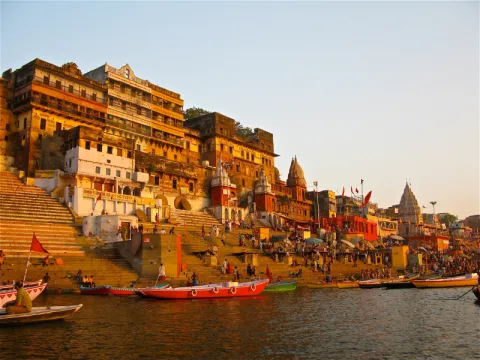
Varanasi, also known as Banaras, stands on the banks of the river Ganga, embodying the quintessence of Hindu spiritual life. This city is not just a place but a living legend, steeped in mythology and history, where the cycle of life and death coexists with startling intimacy. For thousands of years, pilgrims have traversed vast distances to immerse themselves in the sacred Ganga, seeking purification and liberation from the cycle of rebirth. The ghats, with their perpetual fires, are a testament to the Hindu belief in the ritual of cremation as a pathway to enlightenment.
The city vibrates with the sounds of temple bells and the sight of devotees performing the Ganga Aarti at dusk, a mesmerizing ceremony that lights up the river with countless diyas (lamps). Varanasi is also home to the venerable Kashi Vishwanath Temple, one of the twelve Jyotirlingas, making it a pivotal site for Shiva worshippers. The intricate maze of Varanasi’s alleys, filled with ancient wisdom, ashrams, and temples, offers a journey back in time, inviting spiritual seekers to lose themselves only to find their inner peace.
Lumbini, Nepal: Birthplace of the Buddha
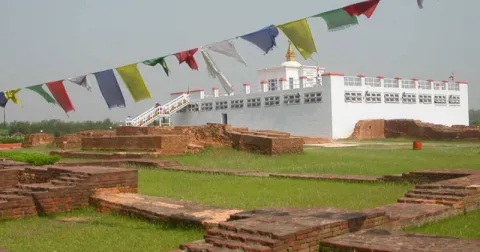
Lumbini, with its serene ambiance, is a sanctuary of peace and contemplation. Marked by the Ashoka Pillar, which commemorates Emperor Ashoka’s pilgrimage and the exact spot of Buddha’s birth, Lumbini is a testament to the profound impact of one of humanity’s greatest spiritual teachers. The site includes the Sacred Garden, which houses the Maya Devi Temple, dedicated to Buddha’s mother. This temple, alongside the sacred Bodhi tree and a sacred pond, creates a tranquil space for meditation and reflection.
Lumbini has evolved into a global symbol of peace and spirituality, hosting monasteries and meditation centers from various Buddhist traditions around the world. This place is not just a pilgrimage destination, but a vibrant international community dedicated to the study and practice of Buddhism, echoing Buddha’s teachings of compassion and non-violence.
Mount Koya, Japan: The Monastic Center
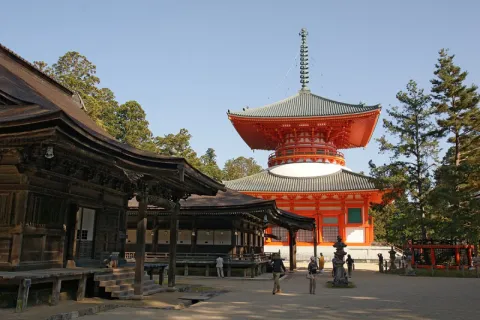
Mount Koya (Koyasan) is the heartland of Shingon Buddhism, a sect known for its esoteric practices and rituals. Founded by the monk Kukai (Kobo Daishi) in the 9th century, this mountainous retreat is surrounded by a pilgrimage trail known as the Koyasan Choishi Michi, marked by ancient stone pillars. The Okunoin Cemetery, leading to Kukai’s mausoleum, is a spiritual journey through a forested path lined with thousands of memorials, including those of samurai, monks, and commoners, illustrating the egalitarian spirit of Buddhism.
Staying in one of Koyasan’s shukubo (temple lodgings) offers an immersive experience into monastic life, including participation in morning prayers, meditation sessions, and the tasting of shojin ryori, the traditional Buddhist vegetarian cuisine. The experience at Mount Koya is a profound retreat from the material world, inviting introspection and understanding of Kukai’s teachings on the nature of the universe.
The Western Wall, Jerusalem: A Beacon of Faith
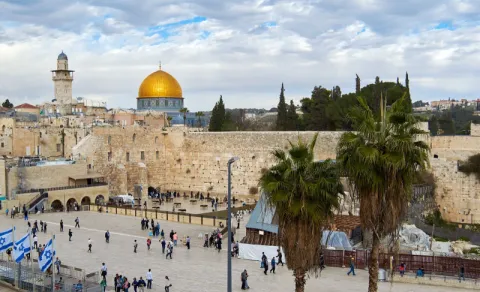
The Western Wall, or Kotel, is the last remaining vestige of the Second Jewish Temple, destroyed by the Romans in 70 CE. It is the most sacred site accessible to Jews for prayer, embodying millennia of Jewish history, aspirations, and prayers. The Wall is a poignant symbol of resilience and enduring faith, where visitors from all corners of the globe come to pray, place notes in the crevices, and connect with a heritage that has withstood the test of time.
The Western Wall Plaza serves as a gathering place for celebrations, national ceremonies, and Bar Mitzvahs, illustrating the vibrant continuation of Jewish life and traditions. The adjacent Western Wall Tunnels allow visitors to explore ancient parts of the wall hidden from view, revealing the architectural marvels of the Temple Mount complex.
Borobudur, Indonesia: The Buddhist Cosmogram

Borobudur, a UNESCO World Heritage site, is a monumental Mahayana Buddhist temple in Central Java, Indonesia. Built in the 9th century, this massive temple complex is both a pilgrimage site and a profound spiritual symbol. Its nine stacked platforms, adorned with relief panels and hundreds of Buddha statues, represent the Buddhist cosmology’s three realms: Kamadhatu (the world of desire), Rupadhatu (the world of forms), and Arupadhatu (the formless world).
Pilgrims and visitors follow a path that mimics the Buddhist journey towards enlightenment, moving upwards through the temple’s levels in a clockwise direction, a process known as pradakshina. Borobudur, especially during the Vesak festival, becomes a focal point of devotion and celebration, illuminating the night sky with lanterns that symbolize the light of the Buddha’s teachings.
The Golden Temple, Amritsar, India: A Sanctuary of Equality
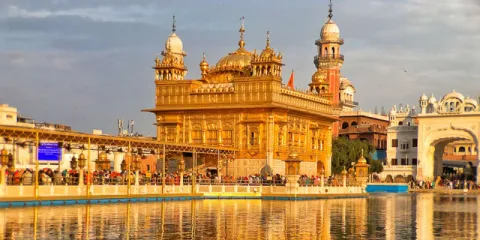
Shwedagon Pagoda, also known as the Golden Pagoda, is not just Myanmar’s most celebrated landmark but a spectacular emblem of spirituality and history. This awe-inspiring structure is believed to be over 2,500 years old, making it the world’s oldest Buddhist stupa. The pagoda’s golden spire, which soars to a height of 99 meters, is encrusted with thousands of diamonds and rubies, serving as a testament to the devotion of the Burmese people to Buddhism. The complex is surrounded by smaller shrines and pavilions, each telling its own story of faith and tradition.
Pilgrims from across the globe and locals alike perform the ritual of circumambulation, walking around the stupa in a clockwise direction with a sense of reverence and awe. The Shwedagon Pagoda is not only a place of worship but also a cultural hub where festivals, religious ceremonies, and everyday moments of devotion paint a vibrant picture of Burmese spiritual life. The energy of the place, especially at dawn and dusk, when the gold reflects the hues of the sun, creates a mesmerizing, almost ethereal experience.
Shwedagon Pagoda, Myanmar: A Beacon of Faith and History
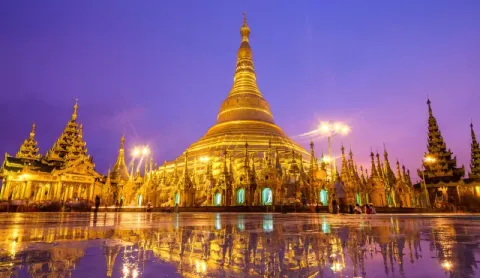
Shwedagon Pagoda, also known as the Golden Pagoda, is not just Myanmar’s most celebrated landmark but a spectacular emblem of spirituality and history. This awe-inspiring structure is believed to be over 2,500 years old, making it the world’s oldest Buddhist stupa. The pagoda’s golden spire, which soars to a height of 99 meters, is encrusted with thousands of diamonds and rubies, serving as a testament to the devotion of the Burmese people to Buddhism. The complex is surrounded by smaller shrines and pavilions, each telling its own story of faith and tradition.
Pilgrims from across the globe and locals alike perform the ritual of circumambulation, walking around the stupa in a clockwise direction with a sense of reverence and awe. The Shwedagon Pagoda is not only a place of worship but also a cultural hub where festivals, religious ceremonies, and everyday moments of devotion paint a vibrant picture of Burmese spiritual life. The energy of the place, especially at dawn and dusk, when the gold reflects the hues of the sun, creates a mesmerizing, almost ethereal experience.
Angkor Wat, Cambodia: Monument to Eternity
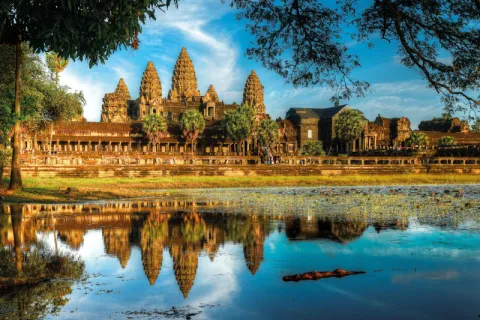
Angkor Wat stands as a symbol of Cambodia’s heart and soul, a monumental tribute to architectural genius and spiritual devotion. Spanning over 162 hectares, this temple complex is an architectural marvel of the ancient world, showcasing the pinnacle of Khmer artistry. This expansive structure is also recognized as the largest religious structure in the world by The Guinness Book of World Records. The temple’s five lotus-like towers rise majestically from the center, symbolizing Mount Meru, the center of the universe in Hindu and Buddhist cosmology.
The bas-reliefs and carvings that adorn the temple walls depict epic stories and myths, including the famous Churning of the Ocean of Milk, a Hindu legend. Angkor Wat’s transition from a Hindu to a Buddhist site mirrors Cambodia’s evolving spiritual landscape. Walking through the corridors, one can’t help but feel transported to a different era, where the divine intersects with the earthly. The temple, at sunrise, offers a moment of profound tranquility and beauty, as the first rays of light illuminate the stone, awakening the gods and goddesses carved into its walls.
The Temple of Heaven, Beijing, China: Harmony Between Heaven and Earth
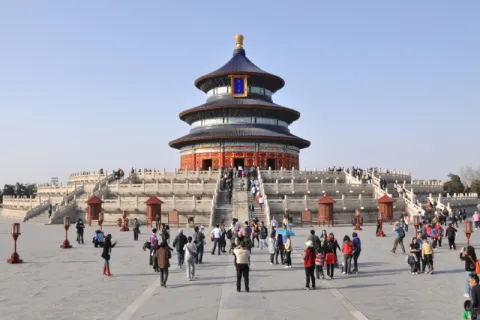
The Temple of Heaven in Beijing, a complex of religious buildings symbolizing the relationship between heaven and earth, was where emperors of the Ming and Qing dynasties performed ceremonies and prayers for good harvests. The temple served as a sacred space where emperors, regarded as the Sons of Heaven, would perform rites and offer sacrifices to ensure the prosperity of the realm. Today, the Temple of Heaven is a tranquil oasis in the heart of bustling Beijing, where visitors can observe locals engaging in tai chi, calligraphy, and other practices that reflect the pursuit of balance and well-being.
The complex is divided into two main sections, the inner temple and the outer temple, each part meticulously planned to align with celestial principles. The Hall of Prayer for Good Harvests, with its iconic triple-gabled circular structure, stands as a stunning representation of the Chinese concept of the universe’s harmony and order. The site embodies the enduring Chinese philosophy that human existence is deeply connected to the cosmos’s rhythm and harmony.
Mount Kailash, Tibet: Pilgrimage to the Roof of the World
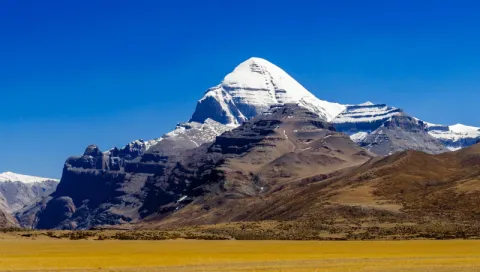
Mount Kailash’s remote location in the Ngari Prefecture of Tibet adds to its mystique and sacredness, standing as a testament to the human spirit’s resilience and devotion. For thousands of years, this has been a pilgrimage site for adherents of multiple religions, each viewing the mountain through the lens of their own spiritual traditions. Hindus regard it as the abode of Lord Shiva, where he resides in a state of perpetual meditation, generating the force that sustains the universe. For Buddhists, it is the home of the Buddha Demchok, who represents supreme bliss.
Pilgrims of these faiths believe that circumambulating the mountain on foot, a strenuous and challenging trek known as a kora, brings significant spiritual merit. It is believed that a single circumambulation erases the sins of a lifetime, while 108 circuits secure enlightenment. The harsh conditions and stark beauty of the landscape accentuate the pilgrims’ spiritual experience, offering moments of profound insight and connection with the divine.
The Batu Caves, Malaysia: A Mosaic of Nature and Devotion
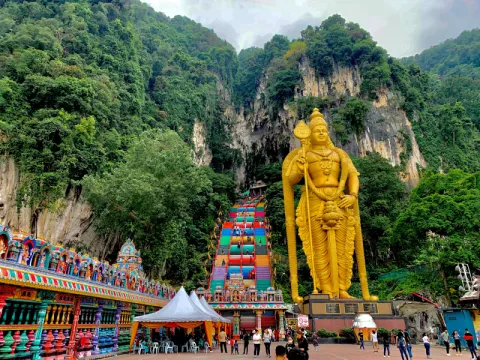
The Batu Caves, with their imposing limestone cliffs and deep cave temples, offer a dramatic backdrop for one of Hinduism’s most vibrant festivals, Thaipusam. The 272-step ascent to the main temple cave is an exercise in devotion itself, as devotees climb towards the sacred space within the mountain. The Cathedral Cave, the largest and most popular cavern, houses ornate Hindu shrines beneath its towering, vaulted ceiling, illuminated by shafts of light from the cave’s openings.
The Thaipusam festival sees devotees undertaking kavadi attam, a dance of burden, where participants carry elaborate structures as acts of penance or thanksgiving, often piercing their skin as a manifestation of faith and endurance. This spectacle of devotion, set against the natural beauty of the Batu Caves, underscores the enduring connection between the spiritual and the natural world, inviting onlookers to reflect on the depth of human faith and resilience.
Spiritual Travel in Asia: Beyond Historical Landmarks and Temples
Spiritual travel in Asia transcends the boundaries of traditional religious sites. It is an expansive journey that encompasses the vast and varied landscapes of the continent, offering a multitude of paths to personal enlightenment and inner peace. This journey ventures deep into the heart of its natural landscapes and cultural practices, providing pathways to peace, self-discovery, and spiritual awakening.
The Harmony of Nature and Spirituality
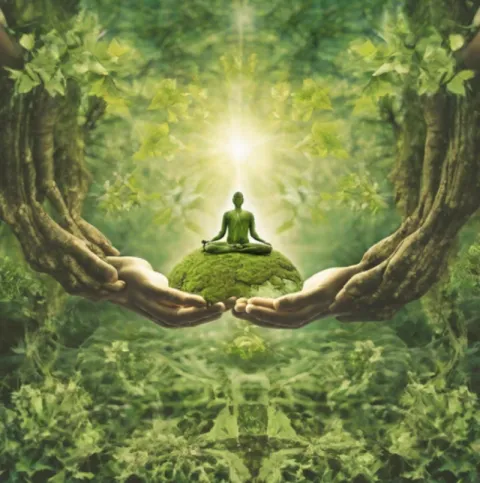
Asia’s natural landscapes are not mere backdrops to its spiritual narrative; they are an intrinsic part of it. The majestic Himalayas, stretching across five countries, are revered as the “abode of the gods.” These towering peaks, including the famed Mount Everest, serve as more than just a challenge for adventurers. They are sacred spaces where many find profound spiritual significance. The serenity of the mountains, coupled with the simplicity of life in their communities, often leads to deep personal reflection and enlightenment.
Similarly, the river Ganga in India represents a journey through the spiritual heart of a nation. More than a river, it’s one of the most prominent holy sites of Asia and a symbol of purification and rebirth. Pilgrims and seekers immerse themselves in its waters, not just for physical cleansing but for spiritual renewal and inner peace. This journey, from the river’s glacial origins down to the plains, mirrors the pilgrimage of the soul toward enlightenment.
The Spiritual Solitude of Deserts

The expansive silence of Asia’s deserts, such as the Gobi in Mongolia, provides a unique setting for introspection. The stark beauty and the vast, open horizons of these deserts offer a perspective on the immensity of nature and our place within it. This setting is ideal for those seeking solitude for meditation, reflection, and a deeper connection with the self.
Cultural Practices Enhancing Spiritual Growth

Beyond its natural wonders, Asia is home to rich cultural experiences that foster spiritual growth. Activities like the meditative tea ceremonies of Japan, the gentle movements of Tai Chi in China, and mindfulness meditation retreats in Thailand provide avenues for tranquillity and self-understanding. These practices, deeply rooted in the cultural fabric of their respective countries, offer a holistic approach to spirituality, blending tradition with personal wellness.
The Emergence of Spiritual Retreats
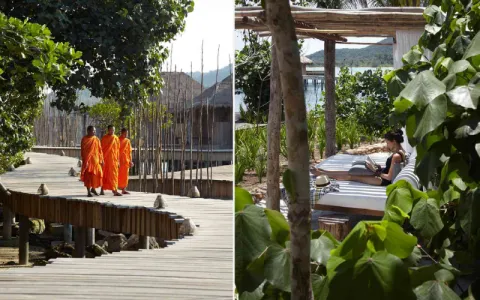
Places like Bali and Thailand have emerged as sanctuaries for those seeking spiritual rejuvenation. These destinations offer a blend of traditional Asian spiritual practices with modern wellness techniques.
Yoga retreats, meditation workshops, and wellness programs in these serene settings provide a sanctuary for individuals to disconnect from the chaos of everyday life and reconnect with their inner selves. These Asian spiritual retreats, nestled in tranquil environments, offer a holistic experience that combines physical well-being with spiritual enrichment.
Organized Spiritual Journeys

The rise of organized religious tours in Asia has further facilitated access to these diverse spiritual experiences. These tours, often led by experienced guides, provide structured itineraries that encompass Asia’s sacred sites, rituals, and cultural experiences. They not only deepen the understanding of the region’s religious traditions but also foster a sense of community among travellers embarking on similar quests for spiritual enlightenment.
Conclusion
The spiritual journey through Asia is an odyssey that transcends mere physical travel. It is a path laden with rich historical narratives, profound cultural insights, and deeply moving personal experiences. Asia’s sacred sites, be it the ancient temples, the holy rivers, or the majestic mountains, are not just points on a map but are the heartbeats of the diverse spiritual traditions that thrive on this continent.
In a world increasingly dominated by material pursuits and digital distractions, a spiritual journey in Asia offers a much-needed respite. It beckons us to slow down, to reflect, and to connect with something greater than ourselves. It is an invitation to explore not just the physical landscapes of this vast and varied continent but also the vast landscapes of our inner worlds.
Book your fondest memory here
Popular Posts
Comfortable Walking Shoes for Travelers
Are you an avid traveler who loves expanding your horizons…
North America’s Most Iconic Street Foods
Street food is a gastronomic treasure concealed in plain sight,…
Exploring Global Cuisines: A Culinary World Tour
People come together over food, and one of the most…
Categories
- Best Places (3)
- Destinations (8)
- Travel (27)
- Travel Products (2)
- Trip Style (5)
- Uncategorized (1)
Search With Tags
Join Our Newsletter
Get Your Daily
Dose
Of Travel Inspiration
"*" indicates required fields

